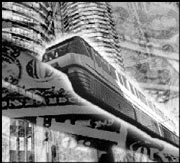SELF-APPOINTED TRANSIT EXPERTS who hoped the monorail would be Seattle’s first free theme-park ride had to swallow a stiff shot of reality on Monday. The Elevated Transportation Company (ETC), the agency set up to implement Seattle’s elevated transit dreams, announced that its 14-mile starter system from Ballard to West Seattle would cost—gulp—somewhere between $970 million and $1.735 billion. That is, although monorail backers hate to resort to such blunt mathematical breakdowns, a range of between $69 million and $124 million a mile.
Why the huge gap between the ETC’s estimates? Monorail backers say the final cost will depend on a number of conditions, including how long the trains are (four-car trains would require larger stations), how the monorail gets across the Duwamish Waterway and the Ship Canal, and what kind of unexpected contingencies come up during preliminary engineering. Final costs and routes, which still form a messy crosshatch on ETC maps, are supposed to be firmed up by next June.
Peter Sherwin, author of the monorail study initiative approved by voters in 2000, says monorail is still a deal compared to Sound Transit’s 14-mile light-rail starter system, which is expected to cost $150 million a mile. “The light-rail people are very concerned that when the [final] numbers come in for monorail, they’re going to be lower and they’re going to be able to build it faster” than light rail, Sherwin says. But skeptics, like light-rail supporter Richard Borkowski, say mono-rail estimates are far too low; Borkowski believes the elevated system will likely cost between $1.5 billion and $2 billion—”about the same as light rail.”
Monorail supporters are at pains to point out that a per-mile estimate—the most popular lexicon of transit pundits citywide—is misleading because some miles are more expensive than others. The mile that runs over the Ship Canal, for example, would cost significantly more to build than the flat, unobstructed mile that runs from 85th to 65th in Ballard, which ETC spokesperson Ed Stone has taken to calling “my favorite mile.”
What’s next for monorail? Narrowing that gaping cost estimate and getting authority from the state Legislature to levy taxes to pay for it all. Monorail backers must also get permission from King County and Sound Transit to run the system, because the two agencies hold exclusive rights to operate transit in Seattle. And they must do it all before November, when some version of the current plan—with cost estimates, routes, and, possibly, a tax proposal—will go before the voters for approval.
Erica C. Barnett







